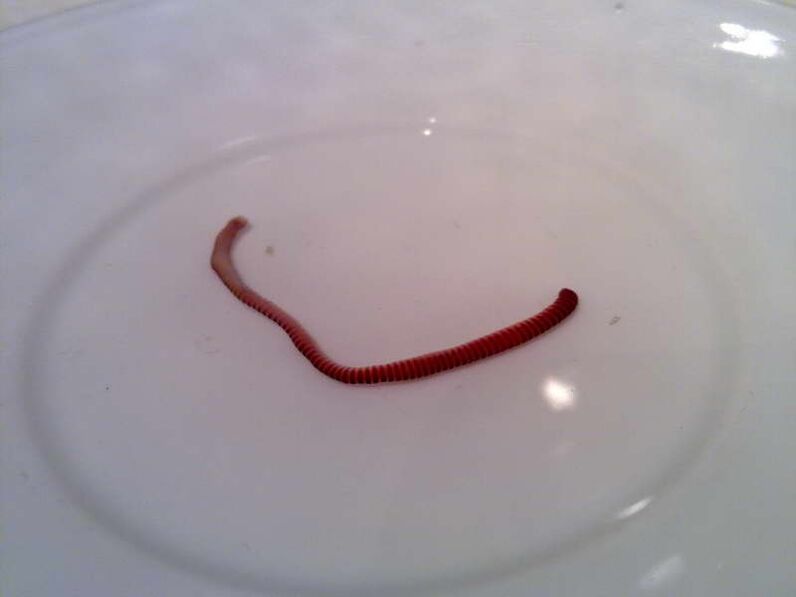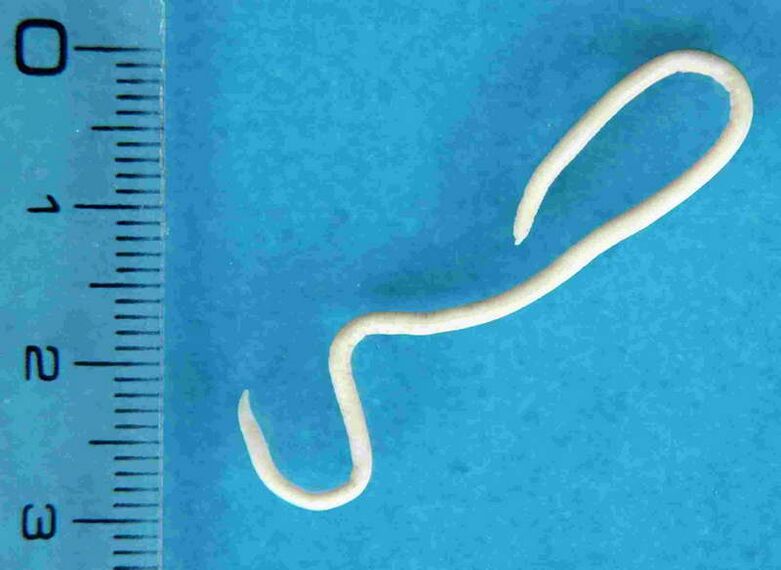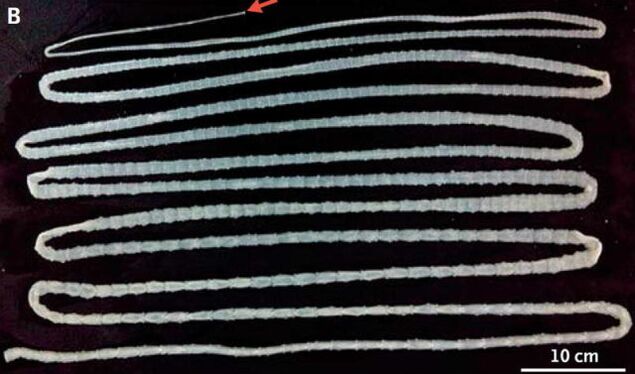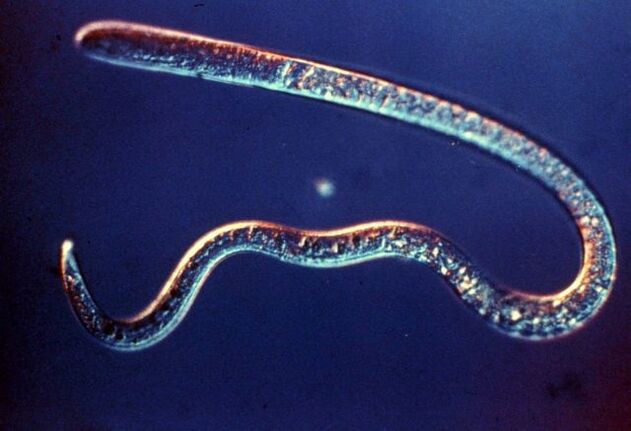Many diseases are caused by helminth infections. Various worms can enter the human body. Their size varies from the smallest millimeter to 16-18 meters. They parasitize all organs and tissues and cause great damage to health. To protect yourself from invasion (infection), it is advisable to know what worms are and how you can get infected with each type of parasite.

Types of worms - what parasites live in the human body
Depending on the location of parasites in the body and the nature of the infection, parasites are divided into several classes.
Classification of worms depending on their location in the human body:
- intestine- These are worms that live in the gastrointestinal tract, mainly in the small intestine. Sometimes they penetrate other organs. This group includes ribbons and roundworms.
- out of the gut- develops, lives and reproduces in various organs outside the intestines. They can be localized in the lungs, eyes, brain, liver. This group includes flatworms.

Classification of worms depending on the method of entry into the human body:
- contagious- is transmitted from an infected person to a healthy person during contact. Other sources of infection are household items: towels, toys. Representatives of this species are dwarf tapeworm, pinworms.
- Biohelminthoses- in contact with animals, as a result of consumption of infected meat that has not undergone adequate heat treatment. In order to be potentially dangerous to humans, these parasites must live in the body of an intermediate host for some time. These include beef and pork tapeworms.
- Geohelminthoses- Part of the life cycle is carried out in the human body, and part in the soil. This is a necessary condition for their development. You can be infected through poorly washed vegetables and fruits. This group includes roundworms, trichinae.
Depending on their biological characteristics, helminths are divided into three types - roundworms, tapeworms, as well as flukes.

Roundworms (nematodes)
Roundworms are so called because their bodies are round in cross section. These parasites are most common in children. These types include:
- PinwormsThey parasitize the large and small intestines. Their body length is not more than 1 cm. Helminthic infestation by pinworms often affects children. These parasites live 1-2 months. If you follow good personal hygiene, you can recover even without medication. If not observed, re-infection is possible.
- Round worm- Worms up to 45 cm long, parasitizing in the small intestine. They can move freely in the intestines. Their lifespan is 14 months. During this period, they release toxins into the bloodstream that systematically poison the body.
- Vlasoqlav- Worms with a body length of 3-4 cm. They parasitize the large and small intestines, digging the mucous membrane to absorb blood. Very toxic. Live up to 5 years.
- Trichinella- The parasite with a crevice of 3-4 mm can be transmitted through meat that does not undergo sufficient heat treatment. Helminths live in various organs, in the muscles of the eyes, heart and lungs. Life expectancy - up to 2 years.
- corn and nekator- have the same biological characteristics, developmental period and method of parasitism, so they are united under the same name "ankylosing spondylitis". These helminths, 10-15 mm long, are localized in 12 of the duodenum. It enters the human body through the skin when in contact with contaminated soil. They feed on blood by biting the blood vessels, which causes iron deficiency anemia. This parasite is difficult to identify.

Tapeworms (cestodes)
The tape has a flat body divided into worm segments. As the worm grows, the segments separate from the body and pass out with the feces. The length of this tape-like individuals is up to 20 m. They parasitize in the intestines, where they stick to the walls with the help of pacifiers.
In order to infect humans, tapeworms must go through one of the developmental stages in the animal's body.
These parasites live in the body for years. Members of this group:
- wide ribbon- Reaches a length of up to 20 m. Parasitizes in the small intestine, causing severe dysfunction of the digestive system. You can become infected by eating freshwater fish and crustaceans that have not undergone heat treatment.
- Taurus formed a ribbon- 6–12 m long helminth. It lives in the small intestine and connects to its mucous membrane with suckers. The source of infection is beef that has not been properly heat treated.
- Established pork- a parasite up to 2 m long, entering the body through raw or poorly processed pork. It adheres to the walls of the small intestine.
- Echinococcus- a parasite that can be transmitted from cats and dogs. A person is an intermediate host for this helminth, so the larvae that enter the body penetrate the tissues, any organs and form echinococcal cysts. They are removed only by surgery.
- Alveococcus- a type of echinococci. Very dangerous helminths that can live in any organ, but mainly parasitize the liver. They actively grow and develop in accordance with the principle of cancer metastases, gradually infecting the whole body. The worms can be removed surgically.

Flukes (trematodes)
Flukes are a type of worm that parasitizes any organ and tissue. They feed on epithelial cells. Their length reaches 1. 5 m. The body is in the form of a leaf. The route of infection is consumption of raw fish, seafood or after inadequate heat treatment. These types include:
- liver tumor- A worm 7-20 mm long. Parasitizes the liver and bile ducts. This leads to the development of serious diseases and functional disorders.
- Fluke- Worm 4-13 mm long, localized in the gallbladder.

Symptoms - signs of worms in humans
How exactly helminthiasis manifests itself depends on the type of worms that affect the body and their number. The main symptoms of helminthic infestation are:
- diarrhea or constipation;
- swelling, flatulence;
- pain in muscles and joints;
- anemia;
- allergic reactions;
- dermatitis;
- weight problems - weight loss or obesity;
- sleep disorders;
- nervousness, irritability, depression;
- apathy, fatigue;
- cough, inflammation of the respiratory tract;
- weakened immunity.

How to determine the presence of worms
If there are symptoms that may indicate the presence of worms, it is worth diagnosing. The following tests will help identify parasites:
- Study of feces.
- Blood test.
- Exploring the secrets of the duodenum 12.
- Analysis of perianal and rectal mucus.
- Ultrasound, tomography, endoscopy.
If you have 3-4 tests every few days, you can be sure of the diagnosis. One analysis is not enough to confirm the absence of helminthic infestation.
The human body can be affected by one type of worm or several types. All of them, regardless of their size, cause serious health problems and are the cause of complex chronic diseases that cannot be treated for years. Periodic diagnostics and preventive treatment are needed to reduce the risk of infection. This is especially true for pet owners.






































